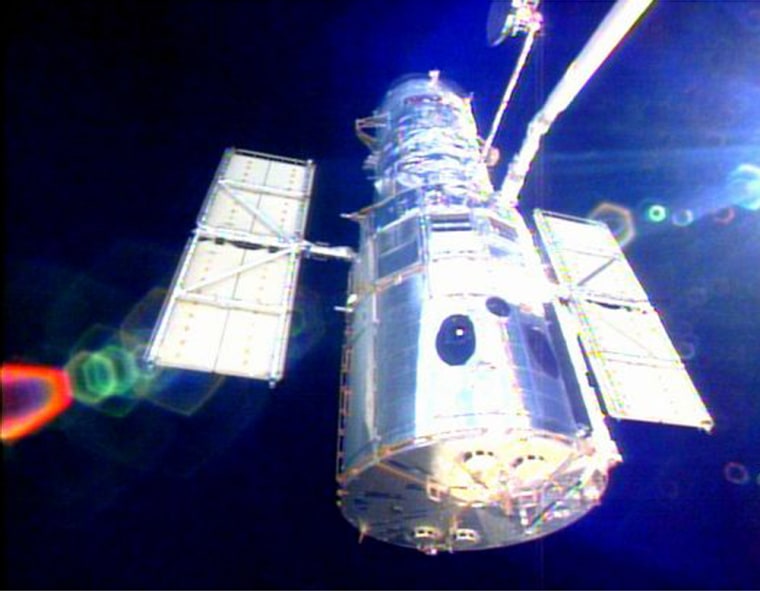NASA took a step on Tuesday toward a robotic repair mission to save the orbiting Hubble Space Telescope. Space agency chief Sean O'Keefe announced that NASA would pursue proposals regarding the feasibility of a robotic servicing mission to the Earth-circling observatory.
O’Keefe made his statement here at the 204th meeting of the American Astronomical Society, attended by about 1,400 astronomers from around the world.
Noting that the Hubble was at first impaired due to its wrongly configured mirror, O’Keefe recalled that the telescope was initially labeled a "techno-turkey." Many skeptics said humans couldn't fix it, he added.
However, dedicated people found ways to fix Hubble's vision. Astronauts not only repaired it, but also over the years have "reinvented the telescope each time" they have traveled to Hubble, he said.
"In the same can-do spirit that propelled the first Hubble servicing mission, I am very pleased to inform this community that NASA is releasing a call for proposals today for a robotic Hubble servicing capability," O’Keefe told an applauding AAS audience.
No astronauts to Hubble
The fate of Hubble has been in question since January, when O'Keefe announced that a planned shuttle mission to send astronauts to the orbiting observatory would not be carried out.
The decision not to shuttle astronauts to Hubble again stemmed from the findings of the Columbia Accident Investigation Board following the loss of crew and space plane on Feb. 1, 2003.
The investigative board advised NASA to defer shuttle missions not bound for the international space station until a shuttle crew can inspect and repair any damage that might occur to their spaceship during ascent into Earth orbit. The Hubble orbits Earth in a different inclination than the space station.
Astronomers and politicians rallied, however, citing the observatory's unique capabilities and public fascination with its images.
Change in culture
O’Keefe said the investigative board recommended that NASA change its culture to a commitment to "prove that it is safe" rather than place the burden of proof on individuals to "prove that it's not safe."
"Well, with that guidance in mind, we're nowhere near close to proving that it's safe. It's not the unknowns we are wrestling with, it's the knowns that we haven't yet devised a way yet to conquer," O’Keefe said of getting the shuttles back in space.
That being the case, O’Keefe said it would not be a responsible course of action to prepare for a servicing mission, only to find that the required actions identified by the board could not be implemented.
Request for proposals
The request for proposals, O’Keefe said, calls for methods in ascending order of complexity: to deorbit the Hubble safely; to extend Hubble's service life by adding batteries and new gyroscopes; and lastly, to install new scientific instruments.
The due date for proposal submissions is July 16.
O’Keefe said that NASA is on a tight schedule to assure a Hubble servicing mission toward the end of 2007. "But we must act promptly to fully explore this approach," he said.
Those proposals, O’Keefe continued, can give NASA the means to judge whether a robotic servicing mission can be mounted in time to replace Hubble's aging batteries, restore the pointing system with new gyros, and install new scientific instruments.
Wanted: telerobotics
NASA is seeking highly dexterous robots assisted by humans on the ground to pursue the Hubble servicing mission.
"What we are looking for is not autonomous robotics, but telerobotics. If this mission goes forward, people will still be servicing Hubble," O’Keefe explained, but they'd do it from afar.
Hubble will eventually be deorbited into the ocean in a controlled manner. The primary mission of any robot that visits Hubble will be to install some sort of deorbiting module that has yet to be designed. Now NASA will consider installing new batteries, gyroscopes and possibly two already-built, advanced science instruments that would enhance the observatory's ability to peer even more deeply into the universe, according to a NASA statement.
In general, such a mission is within the capabilities of robotic machinery already developed by NASA and other institutions, according to NASA's chief scientist, John Grunsfeld, who flew previously on the shuttle to work on Hubble.
Upbeat reaction
"I’m very encouraged," said Steven Beckwith, director of the Space Telescope Science Institute in Baltimore, the organization that oversees the Hubble's science program.
"The public would like to see Hubble continue," he said, "and not just left on life support."
Present at O’Keefe’s talk, Beckwith later said using a robot to put in new astronomical instruments "is a stretch," but he does consider it possible. He was upbeat about the prospects that NASA could sustain the legacy of Hubble’s astronomical exploration.
Michael Shull, chair of astrophysical and planetary sciences at the University of Colorado in Boulder, said he is pleased that the robotic option to service Hubble is there. "But I wish they would consider objectively the option of having the human servicing … and try to be more dispassionate about it. That’s how decisions should be made … dispassionately," he said.
Technology demonstrator
"This is a great opportunity … and a sense of imperative to develop this technology," O’Keefe later told reporters. He said Hubble telerobotic servicing is an "essential technology demonstrator" for the space agency’s broader exploration strategy — the vision of going to the moon, Mars and beyond.
As for cost of such robotic technology, O’Keefe said he could not speculate. "Let’s wait and see what we get in the proposals first," he said.
"I think it is a capability that is required … to be demonstrated as a consequence of the exploration strategy," O’Keefe told Space.com. A key element of that strategy is an autonomous rendezvous and docking capability, he said.
"This provides a sense of immediacy to it that means we won’t be doing a lot of viewgraph engineering," O’Keefe said. "We have a good shot at doing this."
